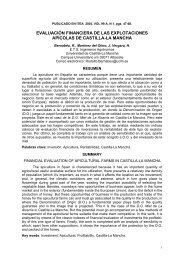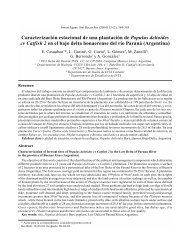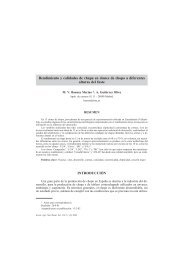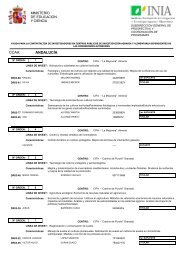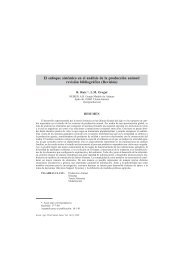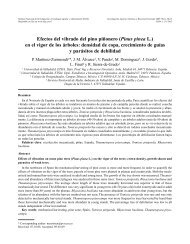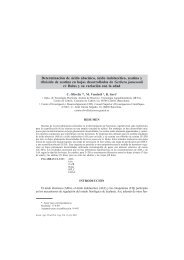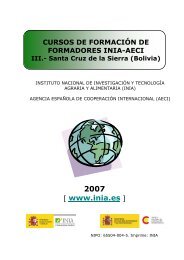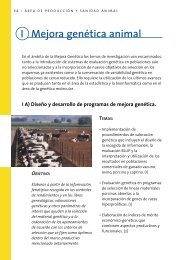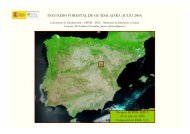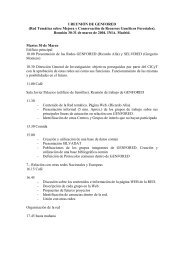Status of medicinal and aromatic plants in - Inia
Status of medicinal and aromatic plants in - Inia
Status of medicinal and aromatic plants in - Inia
You also want an ePaper? Increase the reach of your titles
YUMPU automatically turns print PDFs into web optimized ePapers that Google loves.
130<br />
WORKING GROUP ON MEDICINAL AND AROMATIC PLANTS: FIRST MEETING<br />
Genetic resources <strong>of</strong> <strong>medic<strong>in</strong>al</strong> <strong>and</strong> <strong>aromatic</strong> <strong>plants</strong> <strong>of</strong> Yugoslavia – current<br />
situation <strong>and</strong> further prospects<br />
Zora Dajić<br />
Faculty <strong>of</strong> Agriculture, University <strong>of</strong> Belgrade, Belgrade-Zemun, F.R. Yugoslavia 19<br />
Introduction<br />
Dur<strong>in</strong>g the last decades the dem<strong>and</strong> for <strong>medic<strong>in</strong>al</strong> plant raw material has rapidly <strong>in</strong>creased,<br />
especially <strong>in</strong> developed western countries. This is due to the recent tendency <strong>of</strong><br />
pharmaceutical companies to process the natural, <strong>of</strong>ten cheaper, raw material, but also to a<br />
"modern human conscience" for development <strong>of</strong> alternative heal<strong>in</strong>g methods, such as<br />
aromatherapy <strong>and</strong> homeopathy. The <strong>in</strong>creased use <strong>of</strong> <strong>medic<strong>in</strong>al</strong> <strong>and</strong> <strong>aromatic</strong> <strong>plants</strong> (MAPs)<br />
<strong>in</strong> the last decades <strong>of</strong> the 20 th century was motivated by both emotional <strong>and</strong> rational factors<br />
(Lew<strong>in</strong>gton 1990; Lange 1996, 1998). (The natural products <strong>of</strong> MAPs are believed to have no<br />
adverse effects, be less toxic <strong>and</strong> more appropriate for heal<strong>in</strong>g). Accord<strong>in</strong>g to recent data <strong>of</strong><br />
Traffic International (Lange 1998) the import <strong>of</strong> MAPs <strong>in</strong>to European countries <strong>in</strong>creased by<br />
21% <strong>in</strong> the period 1992-1996.<br />
Significant <strong>and</strong> usually secure <strong>in</strong>come generated by the sale <strong>of</strong> MAPs results <strong>in</strong> a strong<br />
decl<strong>in</strong>e <strong>in</strong> the natural <strong>medic<strong>in</strong>al</strong> flora caused by enormous <strong>and</strong>/or unpr<strong>of</strong>essional<br />
exploitation. In ecologically suitable environments <strong>of</strong> southeastern <strong>and</strong> eastern European<br />
countries, the ma<strong>in</strong> exporters <strong>of</strong> cheap <strong>and</strong> good quality plant raw material, there is a trend<br />
towards the endanger<strong>in</strong>g or complete elim<strong>in</strong>ation <strong>of</strong> many important <strong>medic<strong>in</strong>al</strong> species. The<br />
great floristic richness <strong>and</strong> mapp<strong>in</strong>g <strong>of</strong> certa<strong>in</strong> <strong>medic<strong>in</strong>al</strong> plant habitats <strong>in</strong> Serbia (Kišgeci<br />
et al. 1997; Dajić <strong>and</strong> Kojić 1997, 1998, 1999; Dajić et al. 2000; Kišgeci <strong>and</strong> Sekulović 2000; Dajić<br />
<strong>and</strong> Fabri 2001) enable their exploitation, but simultaneously draw attention to the need for<br />
protection <strong>of</strong> <strong>medic<strong>in</strong>al</strong> plant resources <strong>in</strong> the wild. Therefore this situation requires changes<br />
<strong>in</strong> the legislation <strong>of</strong> MAP protection <strong>and</strong> an <strong>in</strong>crease <strong>in</strong> their production.<br />
Biogeographic situation <strong>of</strong> Yugoslavia <strong>and</strong> elements <strong>of</strong> biodiversity<br />
Yugoslavia is characterized by a huge geographic <strong>and</strong> biological diversity reflected <strong>in</strong> the<br />
richness <strong>of</strong> its <strong>in</strong>digenous flora which exists as various vegetation formations <strong>of</strong> terrestrial<br />
<strong>and</strong> aquatic ecosystems.<br />
Yugoslavia is part <strong>of</strong> the Balkan Pen<strong>in</strong>sula. Its whole territory covers 102 173 km 2 , with<br />
five ma<strong>in</strong> biogeographic regions: (i) Mediterranean, (ii) central European, (iii) pontic,<br />
(iv) boreal <strong>and</strong> (v) central-south European mounta<strong>in</strong>ous (Meusel et al. 1965; Walter 1983;<br />
Stevanović 1994).<br />
Dom<strong>in</strong>ant ecosystems (biomes) <strong>in</strong> Yugoslavia <strong>in</strong>clude deciduous forests, steppes,<br />
coniferous forests, meadows <strong>and</strong> alp<strong>in</strong>e "tundra", as well as the Mediterranean <strong>and</strong> sub-<br />
Mediterranean vegetation distributed <strong>in</strong> the coastal region <strong>of</strong> Montenegro.<br />
Yugoslavia is considered one <strong>of</strong> the 158 world biodiversity centres, based upon the total<br />
number <strong>of</strong> plant species (<strong>in</strong>clud<strong>in</strong>g mosses) (more than 4700). The ma<strong>in</strong> factors <strong>of</strong> such floral<br />
diversity are: historical background, geographical position, climate, relief (with three ma<strong>in</strong><br />
areas: the Panonnian pla<strong>in</strong>, hilly-mounta<strong>in</strong>ous region <strong>and</strong> coastal region <strong>of</strong> Montenegro),<br />
presence <strong>of</strong> streams, etc.<br />
Accord<strong>in</strong>g to the most recent estimates (Stevanović et al. 1995) the flora <strong>of</strong> Serbia conta<strong>in</strong>s<br />
3662 taxa (<strong>and</strong> an estimated additional 120 taxa), i.e. 3272 species <strong>and</strong> 390 subspecies, which<br />
19 Country name changed to Serbia <strong>and</strong> Montenegro <strong>in</strong> February 2003. The denom<strong>in</strong>ation Yugoslavia<br />
(or F.R.Y.) is kept <strong>in</strong> the present text as it was at time <strong>of</strong> meet<strong>in</strong>g <strong>and</strong> preparation <strong>of</strong> this paper.




